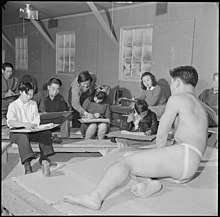Benji Okubo
Benji Okubo (October 27, 1904 in Riverside, California – April 15, 1975 in Los Angeles, California) was an American painter, teacher, and landscape designer. He and his family were held in internment camps during World War II.

He was the eldest of the seven children of Tometsugu "Frank" Okubo and Miejoko Kato. Artist Miné Okubo was his sister.[1]
He studied at the Otis Art Institute in Los Angeles, 1927-1929, where he was awarded prizes.[1] He studied under Stanton MacDonald-Wright at the Art Students League of Los Angeles, and later collaborated with him.[1] Okubo's work was part of group exhibitions at the San Francisco Art Museum and the Los Angeles County Museum of Art.[1]
Okubo served as director of the Art Students League from 1940 to mid-1942,[2] when he was interned at the Pomona Assembly Center outside Los Angeles.[1][3] Later in the year, he was transferred to the Heart Mountain Relocation Center in Wyoming.[4] He and fellow artist Hideo Date initiated evening and Saturday art classes at the internment camp.[4] Date soon withdrew from teaching,[4] but Okubo taught until his release in September 1945.[4] Estelle Peck Ishigo was one of his students.[4] Chisato Takashima was another student, and they married in Billings, Montana on June 12, 1945.[5]
Okubo returned to his landscape design business after his internment.[1] He and his wife had a daughter, Mi-Ya Okubo.
Following his death, widow Chisato Takashima Okubo donated his paintings to the Japanese American National Museum in Los Angeles.[5]
Selected works
- Vision of the Blue Lily (Self-Portrait) (c.1930s), private collection
- Untitled (Green-Faced Woman (c.1930s), Japanese American National Museum, Los Angeles[6]
- Woman with Cat (c.1942-1945), Japanese American National Museum, Los Angeles[7]
- Untitled (Dungeon: Well of Sorrow) (c.1942-1945), Japanese American National Museum, Los Angeles[8]
- Untitled (Impaled Soldier) (c.1942-1945), Japanese American National Museum, Los Angeles[9]
- Untitled (Hand of God) (c.1942-1945), Japanese American National Museum, Los Angeles[10]
- Atom Bomb (1945), Japanese American National Museum, Los Angeles[11]
References
- Okubo, Benji at Japanese American National Museum.
- Will South, "The Art Student League of Los Angeles: A Brief History," in Julia Armstrong-Totten, et al., A Seed of Modernism: The Art Students League of Los Angeles, 1906–1953, Pasadena Museum of California Art. 2008, pp. 1-12.
- Pomona (detention facility) at Densho Encyclopedia.
- Marian Yoshiki-Kovinick, "The Art Student League of Los Angeles: A Japanese American Connection," in Julia Armstrong-Totten, et al., A Seed of Modernism: The Art Students League of Los Angeles, 1906–1953, Pasadena Museum of California Art. 2008, pp. 14-31.
- Phil Kovinick, "The Art Student League of Los Angeles: Selected Artist Biographies," in Julia Armstrong-Totten, et al., A Seed of Modernism: The Art Students League of Los Angeles, 1906–1953, Pasadena Museum of California Art. 2008, p. 117.
- Green-Faced Woman from Japanese American National Museum.
- Woman with Cat from Japanese American National Museum.
- Dungeon: Well of Sorrow from Japanese American National Museum.
- Impaled Soldier from Japanese American National Museum.
- Hand of God from Japanese American National Museum.
- Atom Bomb from Japanese American National Museum.